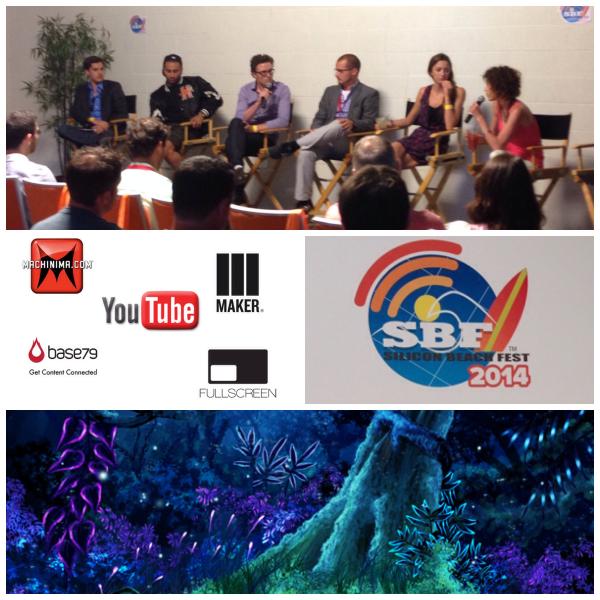YouTube and The New World of Digital Content Creation

YouTube is a booming video platform that in nine short years has evolved into a thriving ecosystem akin to James Cameron's Avatar world, where every bioluminescent plant is an independent YouTube channel and the larger-than-life Eywa trees are MCNs (multi-channel-networks), except they're all making money instead of a thriving collective consciousness. (Ok, perhaps we took that metaphor a little too far.)
Consistent content creation is the name of the game, and YouTube is not alone, affirmed a panel of YouTube celebrities this past week at Silicon Beach Fest in Santa Monica.
Other platforms such as Vimeo, Cracked, UStream and Twitch also vie for eyeballs, page views and monetary gain.
In the YouTube world, many channels design their content around a specific format, though filmmakers, such as Matthew "MatPat" Patrick, a producer of Game Theorists, admit, "building a channel around a format is limiting—how we expand beyond that format, developing a core audience of fans, is probably the key."
Personality channels are the format du jour; however many other formats, including comedy skits, man-on-the-street, pranks and social experiments fluctuate in popularity.
When creating and planning new content, Yousef Saleh Erakat aka “FouseyTube,” asks himself what will catch the audience's attention and expand his viewership beyond just his subscribers. Aspiring YouTube stars would benefit from knowing his answer: In less than one year, FouseyTube's subscribers have grown from 600,000 to 3 million.
Consistent content plays a huge part in how YouTube's algorithm favors and promotes channels. But creativity on-demand is no easy feat for small production teams, which often consist of only the content creator and whatever friends they can put in front of the camera. Many such filmmakers have taken several different approaches to solve this issue.
Some partner with related creators to trade content for eyeballs. Others sign deals with MCNs that provide them with the resources they need to be successful. Others still are taking an episodic approach.
"We're not able to do content all the time," says Patrick. "We've taken a seasonal approach, creating eight episodes for release every Wednesday. Our audience wants the episodes." Game Theorists is in its third season.
Patrick says he spends about 100 hours editing each video. As a result, he spends a great deal of his time studying analytics, figuring out how to best drive traffic and what minor tweaks he can make that will optimize his click-through rate.
The evolution of content channels producing episodic content means this is the first time the platform has truly become a hybrid between YouTube and Netflix. This is also indicative of the fierce competition happening between MCNs—everyone is trying to be ahead of the rest.
The MCNs of YouTube, such as Above Average Productions, Machinima and FullScreen are the digital equivalents of major studios like NBC Universal, FOX and CBS.
Everything is in a constant state of flux. What was true one year ago is no longer true today, explains Taryn Southern, a writer, producer and actress for Taryn TV.
For content creators, signing with an MCN is "about finding the right network for your content," says Matt Clarke, creator of Convos With My 2-Year Old. "Approach a network when you have something to show them."
"It's about finding the right match," affirms Southern. "Whether it's data-driven or a need for higher production value, it's what are they able to provide you."
Then it comes down to negotiating the hell out that contract.
Some filmmakers are fiercely independent and frustrated by the collective power MCNs possess. Others are grateful for the doors such contracts afford.
"MCNs hook up sponsorship deals as much as an agency would do," Erakat says.
With MCNs, creators can "work with fun, similar groups of idiots who are doing funny things online," says Dan O’Brien, head writer and creative director of video for Cracked.com.
There is a push to go off-platform for content creators to "own" their audience and avoid reliance on YouTube.
In a constantly evolving ecosystem, the grassroots guerrilla may soon be an endangered species.
"Whether it becomes a mixture of the 'OGs', the randomly creative, and the business-minded channels, there will always be a blend of business and passion projects that randomly become wildly successful," said Shira Lazar, co-founder and host of What’s Trending.
"At this point in time it is harder to create a YouTube channel than ever before," warns Patrick. "It's all about the watch time and startup momentum" that YouTube's algorithm takes into consideration.
While getting started may be the hardest part, one thing is certain: consistent content will affect an exponential growth in subscribers.
"Get a job—do this on the side," advises O’Brien. "Don't do multiple guerrilla videos just to make a certain amount of money and make yourself feel good."
"YouTube is an easy outlet to work my craft and get better at telling stories," said Patrick. "You can do something and you don't need anyone's permission to do it. [But] if I didn't love it, my channel wouldn't be successful."
Reach Staff Reporter Alex Gold here. Follow him on Twitter here.



